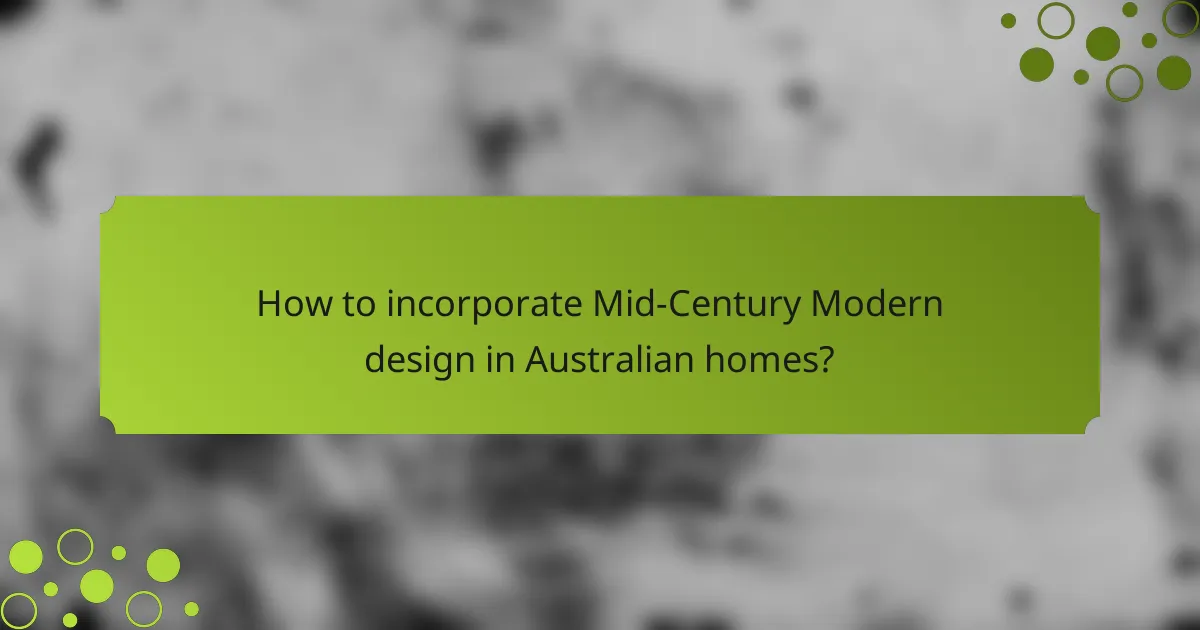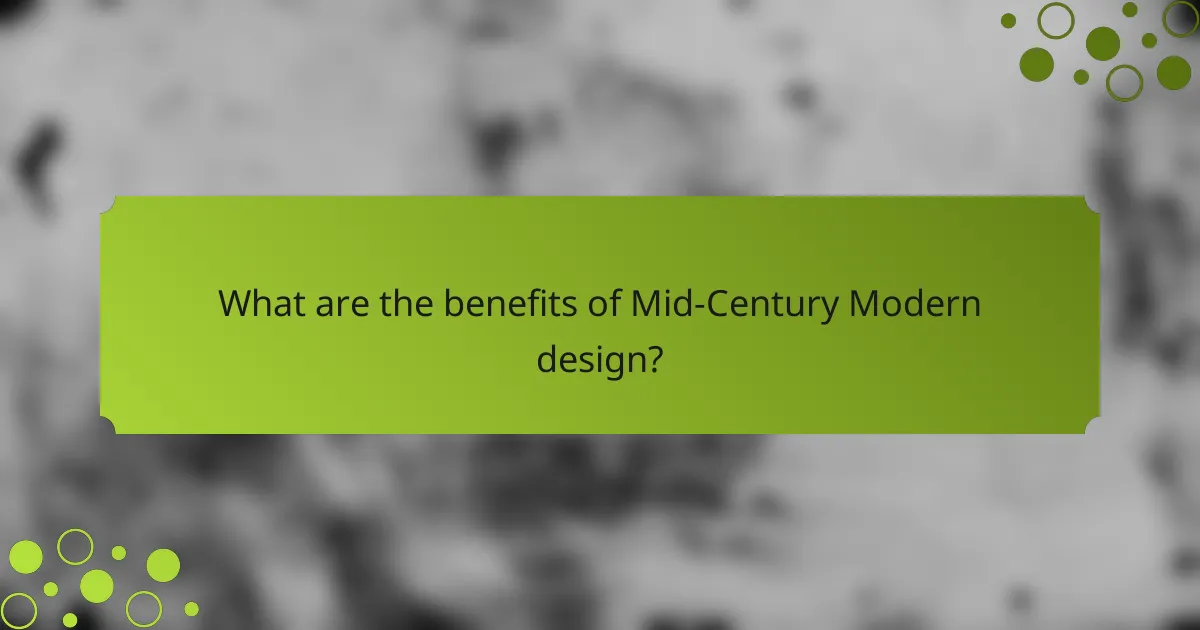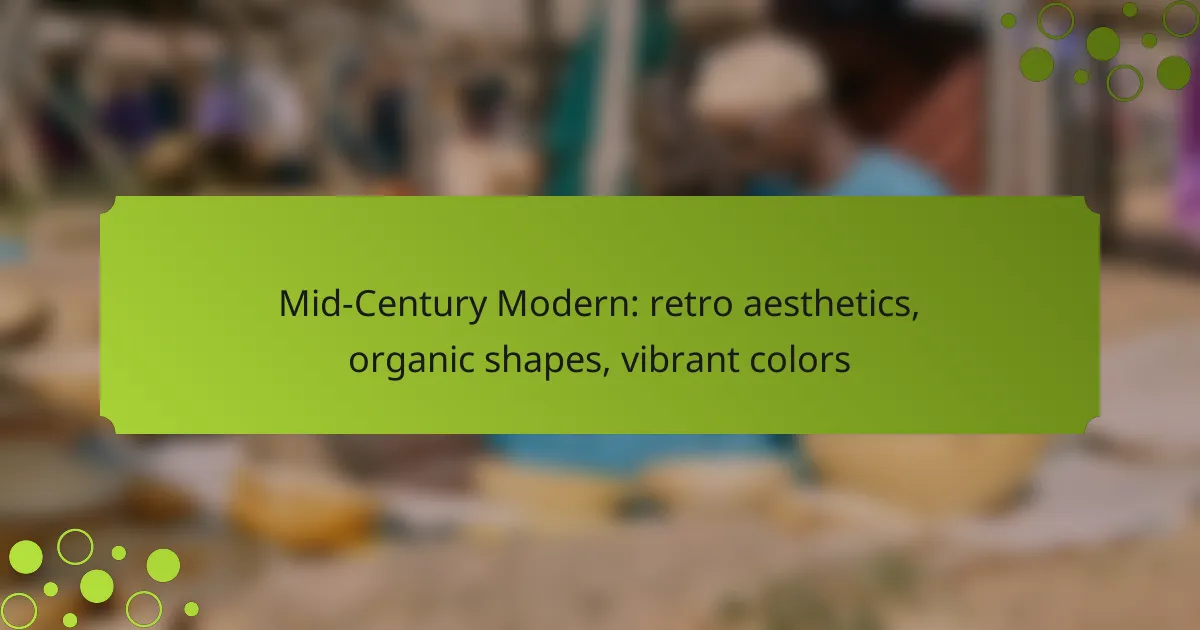Mid-Century Modern design captures the essence of retro aesthetics through its emphasis on organic shapes and vibrant colors. This style harmoniously blends functionality with simplicity, creating inviting spaces that are both practical and visually appealing. Incorporating these elements into Australian homes allows for a unique expression of style that celebrates the charm of the mid-20th century.

How to incorporate Mid-Century Modern design in Australian homes?
Incorporating Mid-Century Modern design in Australian homes involves blending organic shapes, vibrant colors, and retro aesthetics to create a harmonious living space. Focus on selecting furniture and decor that reflect these characteristics while maintaining a functional and inviting atmosphere.
Use organic shapes in furniture
Organic shapes are a hallmark of Mid-Century Modern design, emphasizing fluid lines and natural forms. Look for furniture pieces such as sofas, chairs, and tables that feature rounded edges and asymmetrical designs to enhance the overall aesthetic.
When selecting organic-shaped furniture, consider materials like wood and molded plastic, which can add warmth and texture to your space. Avoid overly angular or rigid designs, as they can disrupt the flow typical of this style.
Choose vibrant color palettes
Vibrant color palettes are essential in Mid-Century Modern design, often incorporating bold hues like teal, mustard yellow, and burnt orange. Use these colors to create focal points in your home, such as accent walls or statement furniture pieces.
To balance vibrant colors, pair them with neutral tones like white, gray, or beige. This approach allows the bold colors to stand out without overwhelming the space. Consider using color in accessories like cushions or artwork for a less permanent commitment.
Integrate retro aesthetics in decor
Integrating retro aesthetics involves selecting decor items that reflect the style’s historical roots. Look for vintage pieces or reproductions that feature geometric patterns, abstract art, or iconic motifs from the Mid-Century era.
Incorporate these elements through textiles, wall art, and decorative objects. Be mindful of scale and proportion, ensuring that decor complements rather than clutters your space.
Opt for iconic brands like Eames
Opting for iconic brands like Eames can elevate your Mid-Century Modern design. Their furniture pieces, such as the Eames Lounge Chair or molded plastic chairs, are timeless and widely recognized for their quality and design.
Investing in these pieces can be a bit pricier, but they often retain value and can serve as statement items in your home. Consider mixing these iconic pieces with other furniture to create a balanced look.
Focus on open floor plans
Focusing on open floor plans is key to achieving the airy feel characteristic of Mid-Century Modern design. This layout encourages natural light and promotes a sense of flow between spaces, making your home feel larger and more inviting.
When designing an open floor plan, consider using furniture to define different areas, such as a sofa to separate the living room from the dining space. Avoid heavy partitions that can disrupt the openness; instead, use rugs or lighting to create visual boundaries.

What are the key characteristics of Mid-Century Modern design?
Mid-Century Modern design is characterized by its focus on clean lines, organic shapes, and vibrant colors. This style emphasizes functionality and simplicity, creating spaces that are both aesthetically pleasing and practical.
Emphasis on simplicity and functionality
Mid-Century Modern design prioritizes simplicity and functionality, often featuring uncluttered spaces and minimal ornamentation. Furniture and decor are designed to serve a purpose while maintaining a sleek appearance.
When selecting pieces, look for items that combine form and function, such as a coffee table that also offers storage. Avoid overly ornate designs that detract from the overall simplicity of the space.
Use of natural materials
This design style frequently incorporates natural materials like wood, leather, and stone, which add warmth and texture to interiors. Common woods used include teak, walnut, and oak, often left with a natural finish to highlight their beauty.
When furnishing a space, consider selecting items made from sustainable sources to align with the organic ethos of Mid-Century Modern design. Look for furniture that showcases the grain and character of the materials used.
Integration with nature
Mid-Century Modern design promotes a seamless connection with nature, often featuring large windows and open spaces that invite the outdoors in. This integration encourages natural light and views of surrounding landscapes.
To enhance this connection, use plants as decor and choose furniture that complements the natural environment. Consider outdoor spaces as extensions of indoor living areas, blurring the lines between the two.
Bold geometric patterns
Bold geometric patterns are a hallmark of Mid-Century Modern aesthetics, often seen in textiles, wallpapers, and artwork. These patterns add visual interest and can serve as focal points in a room.
When incorporating geometric designs, balance them with solid colors and simple forms to maintain harmony in the space. Use these patterns sparingly to avoid overwhelming the overall design scheme.

Where to find Mid-Century Modern furniture in Australia?
To find Mid-Century Modern furniture in Australia, explore a mix of local vintage shops, online marketplaces, and specialized design stores. These sources offer a variety of authentic pieces that reflect the retro aesthetics, organic shapes, and vibrant colors characteristic of this style.
Visit local vintage shops
Local vintage shops are treasure troves for Mid-Century Modern furniture. These stores often curate unique collections, allowing you to discover one-of-a-kind items that may not be available elsewhere. Check out shops in cities like Melbourne and Sydney, where the vintage scene is particularly vibrant.
When visiting, inspect items for quality and authenticity. Look for original pieces rather than reproductions, and don’t hesitate to negotiate prices. Many shops offer delivery options, making it easier to bring your finds home.
Explore online marketplaces like eBay
Online marketplaces such as eBay provide access to a vast selection of Mid-Century Modern furniture from various sellers across Australia. You can find everything from chairs to sideboards, often at competitive prices. Use filters to narrow your search by location, condition, and price range.
Be cautious when purchasing online; always check seller ratings and reviews. Request additional photos and details if needed, and factor in shipping costs when evaluating deals. This approach can help you score great finds without leaving your home.
Check out design stores like Cult
Design stores like Cult specialize in contemporary and classic furniture, including authentic Mid-Century Modern pieces. These retailers often carry well-known brands and designers, ensuring quality and style. Visit their showrooms to see items in person and get a feel for their craftsmanship.
While prices at design stores may be higher than at vintage shops, the investment often pays off in durability and design integrity. Look for sales or clearance items to find quality pieces at a better value. Cult and similar stores also frequently offer online shopping options for convenience.

What are the benefits of Mid-Century Modern design?
Mid-Century Modern design offers a blend of aesthetic appeal and functional benefits, making it a popular choice for many homeowners. Its emphasis on organic shapes, vibrant colors, and simplicity creates spaces that are both stylish and practical.
Timeless appeal
One of the key benefits of Mid-Century Modern design is its timeless appeal. The clean lines and minimalistic approach ensure that these designs remain relevant across decades, making them a wise investment for homeowners.
Furniture and decor from this era often feature classic materials like wood and metal, which age beautifully and complement various styles. This versatility allows for easy integration into both contemporary and traditional settings.
Enhances natural light
Mid-Century Modern design prioritizes open spaces and large windows, which significantly enhance natural light in a home. This focus on light not only makes interiors feel more spacious but also creates a warm and inviting atmosphere.
When designing with this style, consider using sheer curtains or no window treatments at all to maximize light exposure. Additionally, reflective surfaces like glass and polished wood can help distribute light throughout the space.
Promotes a relaxed atmosphere
The organic shapes and soft curves typical of Mid-Century Modern design contribute to a relaxed atmosphere. This style encourages comfort and ease, making it ideal for creating cozy living spaces.
Incorporating elements such as low-profile furniture and open floor plans can enhance this feeling. Aim for a balance of functionality and comfort, ensuring that spaces invite relaxation and social interaction.

How does Mid-Century Modern compare to other design styles?
Mid-Century Modern stands out for its emphasis on simplicity, organic forms, and vibrant colors, distinguishing it from other design styles. Unlike more ornate styles, it prioritizes functionality and clean lines, making it a timeless choice in contemporary design.
Differences from Scandinavian design
Mid-Century Modern and Scandinavian design both value functionality, but they differ significantly in aesthetics. Scandinavian design often features a more muted color palette and a focus on minimalism, while Mid-Century Modern embraces bold colors and playful shapes. Additionally, Mid-Century pieces frequently incorporate materials like plastic and metal, contrasting with the wood-centric approach of Scandinavian design.
Similarities with Bohemian style
Mid-Century Modern and Bohemian style share a love for vibrant colors and eclectic patterns, creating visually stimulating spaces. Both styles encourage the use of organic shapes and natural materials, fostering a relaxed and inviting atmosphere. However, while Mid-Century Modern maintains a more structured approach, Bohemian style leans towards a free-spirited and layered aesthetic, allowing for greater personal expression.
